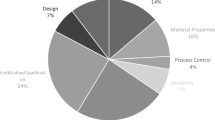Abstract
The flexibility of modular fixturing systems can be exploited to significantly enhance the productivity of computer integrated manufacturing facilities. A major impediment to the implementation of this philosophy is the absence of viable methodologies for the automated design and assembly of these fixturing systems. This paper addresses this technological void by proposing a CAD/CAM tool for the automated design and robotic assembly of modular fixturing systems which can form the basis for a fully automated design system. The development of automated flexible fixturing technologies that transcend the traditional time-consuming and expensive practice of manual assembly would significantly contribute to the evolution to the factory-of-the-future.
Similar content being viewed by others
References
M. E. Merchant, cited inComputerized Manufacturing Automation: Employment, Education, and the Workplace, Washington DC, US Congress, Office of Technology Assessment, OTA-CIT-235, April 1984, pp. 60–61.
Computerized Manufacturing Automation: Employment, Education, and the Workplace, Washington DC, US Congress, Office of Technology Assessment, OTA-CIT-235, April 1984, p. 96.
B. S. Thompson, ‘Flexible fixturing-a current frontier in the evolution of flexible manufacturing cells’, ASME Paper No. 84-WA/Prod-16, 1984.
B. S. Thompson and M. V. Gandhi, ‘A commentary on flexible fixturing’, ASMEApplied Mechanics Reviews,39 (10) October 1986, pp. 1365–1369.
M. V. Gandhi and B. S. Thompson, ‘Phase-change fixturing for FMS’,Manufacturing Engineering,93 (6), December 1984, pp. 79–80.
M. V. Gandhi and B. S. Thompson, ‘Phase-change fixturing for flexible manufacturing systems’,Journal of Manufacturing Systems,4 (1), 1985, pp. 29–39.
M. V. Gandhi and B. S. Thompson, and D. J. Maas, ‘Adaptable fixture design: an analytical and experimental study of fluidized-bed fixturing’, ASMEJournal of Mechanisms, Transmissions and Automation in Design,101 (1), 1986, pp. 15–21.
‘Machine tool makers: healing, but sickly’,Business Week, October 1, 1985, pp. 119–120.
M. Waldish, ‘On the edge of a snake pit-FMSs are a boon if used with careful planning, but few achieve this’,Engineer, October 1982,255, pp. 32–33.
G. Lewis, ‘Modular fixturing systems’,Proceedings of the 2nd International Conference on Flexible Manufacturing Systems, (ed. K. Rathmill), pp. 451–462, October, 1983, London, UK, North Holland Publishing Company.
J. C. Quinlan, ‘New ideas in cost-cutting, fast-change fixturing’,Tooling and Production, April 1984, pp. 44–48.
M. V. Gandhi and B. S. Thompson, ‘Automated design of modular fixtures for flexible manufacturing systems’,Journal of Manufacturing Systems,5 (4), 1986, pp. 243–252.
H. Hammer and J. Schuster, ‘A new approach for flexible automation in boring and milling operations’, Tages Zeitung für metallberabeitung’,77 (5), 1983, pp. 7–17.
B. Krauskopf, ‘Fixtures for small batch production’,Manufacturing Engineering, January 1984, pp. 50–53.
A. Markus, Z. Markus, J. Farkas and J. Filemon, ‘Fixture design using Prolog: an expert system’,Robotics and Computer-Intergrated Manufacturing,1 (2), 1984, pp. 167–172.
Author information
Authors and Affiliations
Rights and permissions
About this article
Cite this article
Grippo, P.M., Gandhi, M.V. & Thompson, B.S. The computer-aided design of modular fixturing systems. Int J Adv Manuf Technol 2, 75–88 (1987). https://doi.org/10.1007/BF02601478
Issue Date:
DOI: https://doi.org/10.1007/BF02601478




